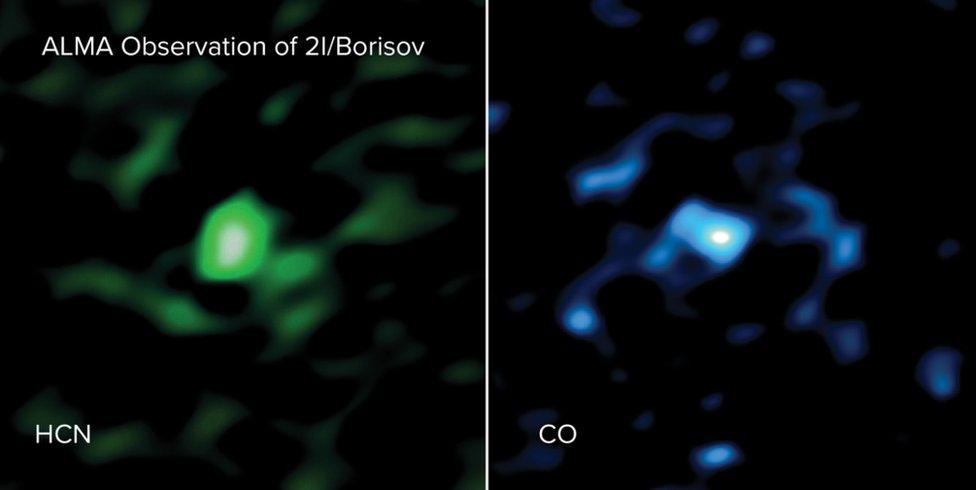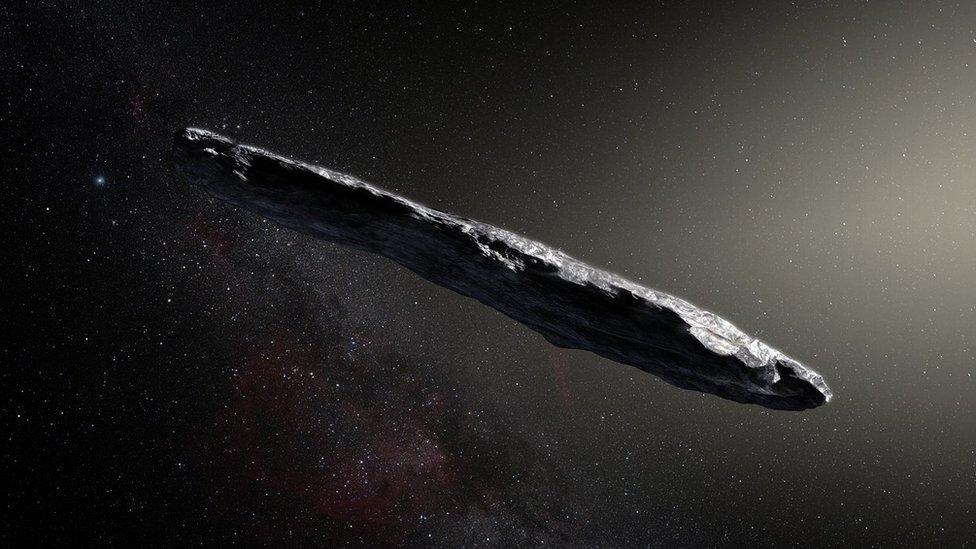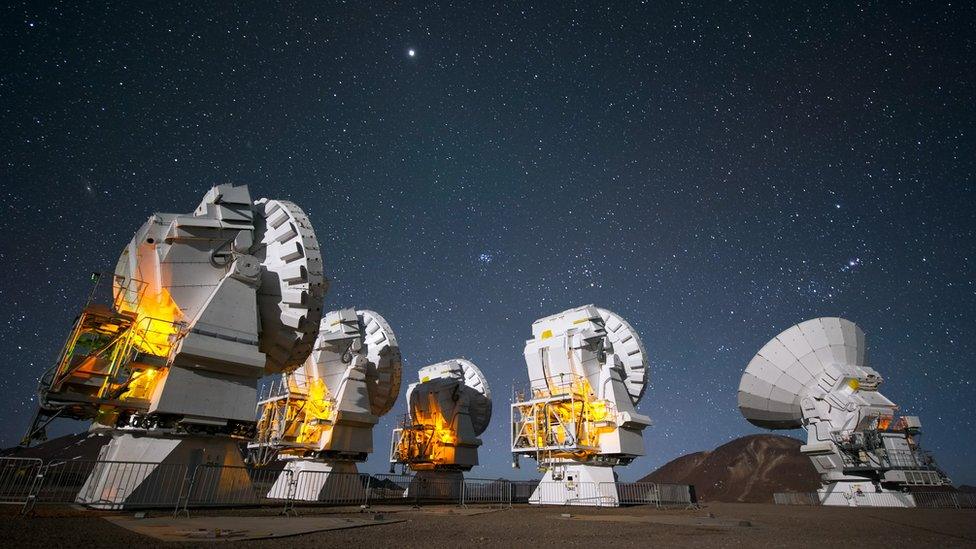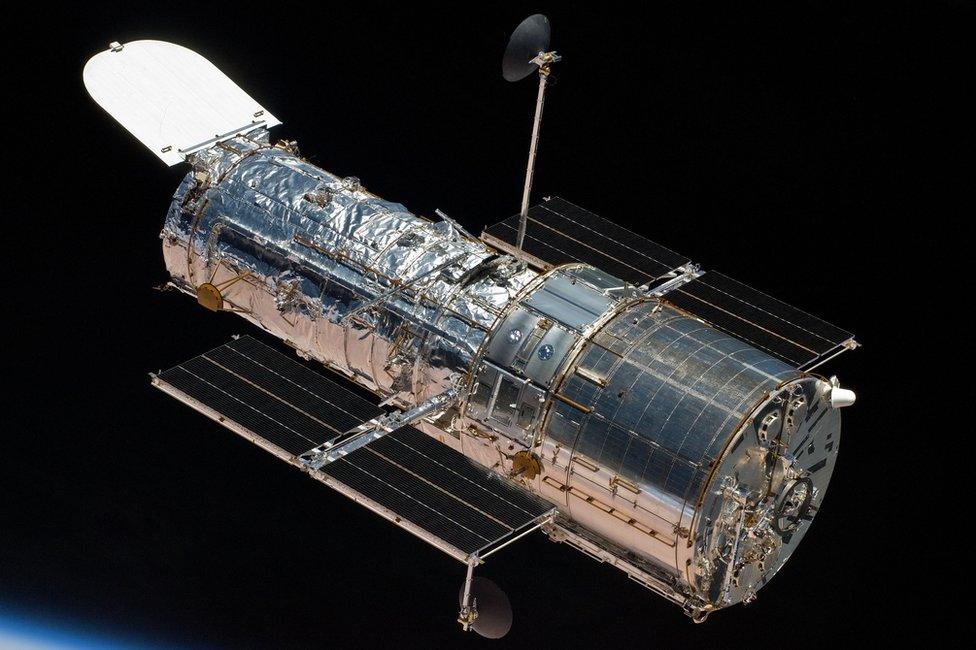'Alien comet' visitor has weird composition
- Published

Artwork: The interstellar visitor was detected in our Solar System last year
The first known comet to visit us from another star system has an unusual make-up, according to new research.
The interstellar comet 2I/Borisov was detected in our Solar System last year.
This mysterious visitor from the depths of space has provided astronomers with an unprecedented opportunity to compare it to comets that formed around the Sun.
New data suggests it contains large amounts of carbon monoxide - a possible clue to where it was "born".
The findings appear in two separate scientific papers published by Nature Astronomy.
In one of the papers, external, an international team led by Martin Cordiner and Stefanie Milam from the US space agency's (Nasa) Goddard Space Flight Center in Greenbelt, Maryland, pointed the Atacama Large Millimeter/submillimeter Array (Alma), external toward the comet on 15 and 16 December 2019.
Alma consists of 66 antennas on a mountaintop in Chile that observe the sky at sub-millimetre wavelengths.
In the other study, external, Dennis Bodewits from Auburn University in Alabama and colleagues gathered ultraviolet observations of 2I/Borisov using the Hubble Space Telescope (HST), external and the Neil Gehrels Swift Observatory, external.

Two compounds were detected: Hydrogen cyanide (HCN) is common in comets from our Solar System, but carbon monoxide (CO) was found at unusually high concentrations
Comets are made up of gas, ice, and dust; they form swirling in the disc of material that surrounds a star when its planets are being born. They can seed young worlds with the chemicals necessary for life, and may have brought water to the early Earth.
The teams identified two molecules in the gas ejected by the comet: hydrogen cyanide (HCN) and carbon monoxide (CO).
HCN has already been detected in this interstellar vistor, and is present at similar amounts to those found in Solar System comets.
However, they were surprised to see large amounts of CO. The researchers using Alma for their observations estimated that 2I/Borisov's CO concentration was between nine and 26 times higher than that of an average Solar System comet.
"This is the first time we've ever looked inside a comet from outside our Solar System," said Dr Cordiner, "and it is dramatically different from most other comets we've seen before."
Dr Ye Quanzhi, an astronomer at the University of Maryland in College Park, called the results "very cool and surprising".
The researcher, who was not involved with the studies, told BBC News: "We have learned in the past couple months that Borisov is similar to the 'dynamically new' comets in our Solar System (i.e. the indigenous comets which formed in the edge of the Solar System and tend to have a higher CO concentration), so a high-ish CO abundance is [kind of] expected, but such a high CO level (at least a couple times higher than typical Solar System comets) is very surprising - at least to me."

Artwork: 'Oumuamua, detected in 2017, was the first known visitor from outside the Solar System
He added: "It's nice to see that different teams of astronomers working at different wavelengths (Hubble in ultraviolet, Alma in radio) are able to confirm each other's results".
Carbon monoxide is common in space and is found inside most comets. But, for reasons which remain unclear, there's huge variation in the concentration of CO in these icy objects.
This might be partly related to where in a star system a comet was formed. It may also be connected to how often a comet's orbit brings it closer to its star and leads it to release its more easily evaporated ices.
Nevertheless, said Dr Cordiner, "if the gases we observed reflect the composition of 2I/Borisov's birthplace, then it shows that it may have formed in a different way than our own Solar System comets, in an extremely cold, outer region of a distant planetary system".
Dr Milam commented: "The comet must have formed from material very rich in CO ice, which is only present at the lowest temperatures found in space, below -420F (-250C)."

Some of the observations were gathered using the Alma antennas in Chile
Dr Cordiner added that Alma had previously observed discs of dust and gas - from which planets are formed - surrounding young low-mass stars similar to the Sun.
"Many of these discs extend well beyond the region where our own comets are believed to have formed, and contain large amounts of extremely cold gas and dust. It is possible that 2I/Borisov came from one of these larger discs."
Dr Bodewits offered a distinct take, arguing the comet could have originated around a red dwarf star, the most common type in the Milky Way galaxy. "These stars have exactly the low temperatures and luminosities where a comet could form with the type of composition found in comet Borisov," he explained.
Based on its high speed (33km/s; 21 miles/s), astronomers suspect 2I/Borisov was flung out of its host system after a close encounter with a passing star or giant planet.
It then spent millions or billions of years on a lonely journey through interstellar space before its discovery on 30 August 2019 by amateur astronomer Gennady Borisov.

One of the teams carried out observations in the ultraviolet using the Hubble Space Telescope
Astronomers continue to study the interloper, and recent observations of the comet's behaviour suggested it was fragmenting, external.
"I do think Borisov broke into two - HST observed the comet at two different times and both showed the break-up," said Ye Quanzhi. "Our follow-up observation (led by Qicheng Zhang of Caltech) was made a few days after the initial discovery, and seemingly showed some evolution of the event - it seems one of the fragments was reduced to a blob of dust."
2I/Borisov is only the second interstellar object to be detected in our Solar System.
The first, known as ʻOumuamua, was discovered in October 2017, at which point it was already high-tailing it out of our cosmic neighbourhood. While initially classified as a comet, it showed no signs of the outbursts of gas and dust characteristic of these objects (and observed in 2I/Borisov).
A study published earlier this month in Nature Astronomy, external suggested ʻOumuamua, which has a highly elongated shape like a cigar, could be a shard from a planet ripped apart by its host star's gravity.
Follow Paul on Twitter., external